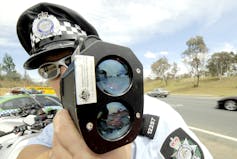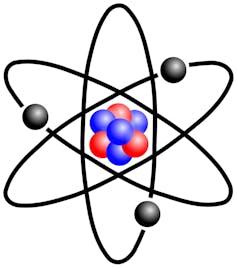The term “uncertainty principle” suggests some grand philosophical idea, like “you can never be sure of anything”, or “there are some things you can never be sure of” and sometimes people use it as if this is what is meant.
In fact, this principle discovered by German theoretical physicist Werner Heisenberg in 1927, has a precise technical meaning that’s typically relevant only to microscopic particles. But it does have implications for how we understand the universe and our relation to it, and also to new technologies of the 21st century.
Uncertainty about what?

While the Heisenberg Uncertainty Principle (HUP) does not mean “there are some things you can never be sure of”, it does imply “you can never be sure of everything.” How can this be? If you can never be sure of everything, doesn’t that mean there are some things you can never be sure of? Surprisingly, no.
In science we are ultimately concerned with what we observe. So when we say we are uncertain about something, we mean that we are uncertain about what we will observe when we do an experiment.
Of course, life would be pretty boring if we could always predict what was going to happen next, but for many centuries scientists dreamt they would be able to do this. The HUP killed that dream in a very interesting way.
The simplest example of the HUP is the following: You can never be certain of both the position and the speed of a microscopic particle. It is possible to arrange an experiment so you can predict the position of a particle. A different experiment would let you predict its speed. But you will never be able to arrange things so that you can be certain of both its position and its speed.
You might be jumping up and down at this point and saying “That’s ridiculous. If I want to know both I just measure them simultaneously. Or I first measure the position, then the speed.” In fact, neither of these options will work, and what rules them out is other forms of the HUP itself.
In the first case, there is the HUP that says it is not possible to simultaneously measure position and speed with perfect accuracy. In the second, there is the HUP that says if you accurately measure the position you will disturb its speed, making it more uncertain, and vice versa. So you can’t get around it.
Is it a Principle?

Before getting into the details, one thing to get clear is that Heisenberg’s “uncertainty principle” is not really a principle at all. A “principle”, in science as in everyday life, is a fundamental simple idea from which all sorts of other things can be derived, such as the principle of freedom, or the principle of fairness.
Heisenberg’s principle is not like that – it’s actually a consequence of something more fundamental. That thing is quantum mechanics, a theory that applies to all forms of matter and energy (as far as we can tell).
Unfortunately, although quantum mechanics seems fundamental, it’s not simple, and so cannot be encapsulated as a principle. But from it follow all forms of the HUP.
Precisely uncertain
For the example given earlier, Heisenberg’s principle can be precisely stated as:
(1) Δq x Δv > ħ/m
Here Δq is the uncertainty in the position of the particle (in metres), Δv is the uncertainty in its speed (in metres per second), m is its mass in kg, and ħ is a constant (Planck’s constant divided by 2*pi).
Note that the two uncertainties are multiplied together in equation (1), and the result must be greater than some number. This means that, although Δq can be as small as you like as long as Δv is large enough, or vice versa, they cannot both be arbitrarily small.
The HUP in its looser form (“you can never be sure of everything”) is thus a consequence of the fact that Planck’s constant is not zero. But Planck’s constant is very small. In the units used here, ħ ≈ 10-34; that is 0.00 … 001, where there should be 34 zeros here. This smallness is why we don’t have to worry about the HUP in everyday life.

You may have heard the anecdote about a woman who is stopped by a policeman who says: “I just measured your speed as 53.9 km/hr when you were in a 40 km/hr school zone.” She retorts: “Are you familiar with the Heisenberg Uncertainty Principle? If you are so sure about my speed, you can’t possibly know where my car was.”
It’s a cute joke, but let’s see what the HUP actually says. When the policeman says the speed was measured as 53.9 km/hr, he presumably just means it was closer to 53.9 than to 53.8 or 54.0. This means an uncertainty of about 0.05 km/hr, which is about 0.01 metres/second. If the mass of the car is 1,000kg then the HUP implies:
Δq > ħ/(m x Δv) ≈ 10-35 /(1000x0.01) = 10-36 metres
Thus the minimum uncertainty in the position of the car implied by the HUP is much, much smaller than the size of an atom. So this is obviously irrelevant when it comes to the question of whether the car was in the school zone or not.

Although the HUP doesn’t have much to say about speeding tickets, it’s ubiquitous at the scale of atoms and sub-atomic particles. The mass of an electron is extremely small (m ≈ 10-30 kg) so that ħ/m ≈ 10-5 on the right-hand-side of equation (1) is no longer ridiculously small.
In fact, some simple arguments involving the motion of electrons around the nucleus of an atom let us derive the approximate size of an atom as the minimum Δq ≈ 10-10 meters implied by the HUP. The HUP in one form or another is a useful principle in almost every field of science dealing with very small amounts of matter or energy.
Applications in technology; implications in philosophy
Since quantum mechanics underlies almost all modern technology, the HUP turns up all over the place. It also plays a more direct role in the quantum technologies of the 21st century, which are just being developed now.
Quantum communication allows the sending of encoded messages that are un-hackable by any computer. This is possible because the messages are carried by tiny particles of light called photons.
If an eavesdropper attempts to read out the message in transit, they will be discovered by the disturbance their measurement causes to the particles as an inevitable consequence of the HUP.
The HUP also raises fascinating and difficult philosophical questions. The most obvious question is: what’s the reason for this uncertainty?
In everyday life we could be uncertain about whether the cue ball will end up going into the top pocket because we are uncertain about its speed or position. But we would not doubt that the ball has a speed and position.
In the regime of quantum experiments, by contrast, we are uncertain about the results of experiments because the particle itself is uncertain. It has no position or speed until we measure it. Or so Heisenberg thought, and most physicists still follow this line.
However, others strongly disagree with this conclusion and the debate is not over – that’s for certain.
See more Explainer articles on The Conversation.

